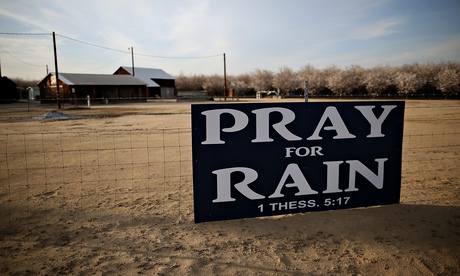
A sign in Turlock, California where water scarcity has had a severe effect on energy production, as well as agriculture.
Via The Guardian, a report on the

A sign in Turlock, California where water scarcity has had a severe effect on energy production, as well as agriculture.
All hydro, no power?
Yesterday afternoon I made a list. I’d like to share it with you: Alon, Solar Alliance, Eskom, GDF Suez, Iberdrola, Ranhill Berhad, Sasol. Can you guess what it’s about? If not, don’t fret. All will be revealed.
I made the list while perusing the website of the CEO Water Mandate. The Mandate, part of the UN Global Compact, was established in 2007 “to assist companies in the development, implementation, and disclosure of water sustainability policies and practices”. It’s the most prominent of the various global platforms which aim to help businesses to understand and address water-related risks.
As of yesterday, the CEO Water Mandate website listed 74 signatory companies. The seven companies I’ve listed above were, as far as I could tell, the only signatories from the energy sector.
By way of comparison, I counted more than 20 companies on the list from the agriculture, food and beverage sector and about a dozen from the pulp and paper industry. This got me thinking, as I seem to do quite often lately, about the food-water-energy “nexus” (a terrible word but it’s all the rage now; I’d be delighted if someone can suggest a better alternative). Specifically, I found myself wondering whether the energy sector has fully grasped the potential implications of this 21st century resource trilemma.
In a recent blog, Diego Rodriguez and Marcelino Madrigal from the World Bank set out the impacts water scarcity could have on energy production. They listed shut-downs, expensive refits and capacity reductions which had hit power plants in Australia, South Africa, the US and India.
Reuters recently reported energy price hikes and possible power rationing in Brazil as a result of drought. Analysis by the International Energy Agency adds further weight to the call for water and energy planners to spend more quality time together. The IEA reckons that water use by the energy sector will rise dramatically in the next few decades and that access to water could be a challenge for power generators in many countries.
The risks are here and now, and they are likely to intensify. As an aside, the IEA analysis concluded that development pathways focused on energy efficiency, solar PV and wind power wouldn’t intensify water needs substantially, an assessment backed up by recent research from the universities of Newcastle and Oxford: a win-win for energy, for water security and for global sustainability.
So is the sector being complacent? In most countries, energy generation has been regarded historically as a strategic priority when it comes to water allocation, for understandable reasons: if there’s no power, economies grind to a standstill. But as the world gets thirstier, and water use trade-offs become more painful, this may not always be the case in the future.
To ensure that allocations properly balance the needs of different sectors, and the needs of upstream and downstream users in a river basin, companies in many world regions are beginning to engage with stakeholders and governments.
The food and beverages sector has grasped the bull (or should that be water buffalo?) by its hydrological horns and several blue chip businesses have begun to assess and manage their water risks. The tools they are using – such as WWF’s Water Risk Filter – could help energy companies identify and address hotspots and priorities for action.
The real pioneers have understood that risks from acute drought, chronic scarcity or pollution can’t be addressed just by improving efficiency and effluent control within the factory fence-line. Companies such as Coca-Cola and SABMiller are working hard with a range of players to avoid river basin scale tragedies of the commons.
There are signs that the energy sector has begun to take note. The oil and gas industry, through its environmental association (IPIECA), has developed water guidelines. Last year, a BP-sponsored report (PDF) on the issue was published.
But, while its analysis was authoritative, this report served to highlight the fact that the energy sector seems to be missing a trick. It scarcely mentioned sources of water risk stemming from broader patterns of resource use. The emphasis was on water in the energy industry, rather than water and the energy industry.
The CEO Water Mandate isn’t the only game in town and signing up doesn’t mean that companies have got their water issues completely under control. All the same, it would be good to see my list grow.
You must be logged in to post a comment.